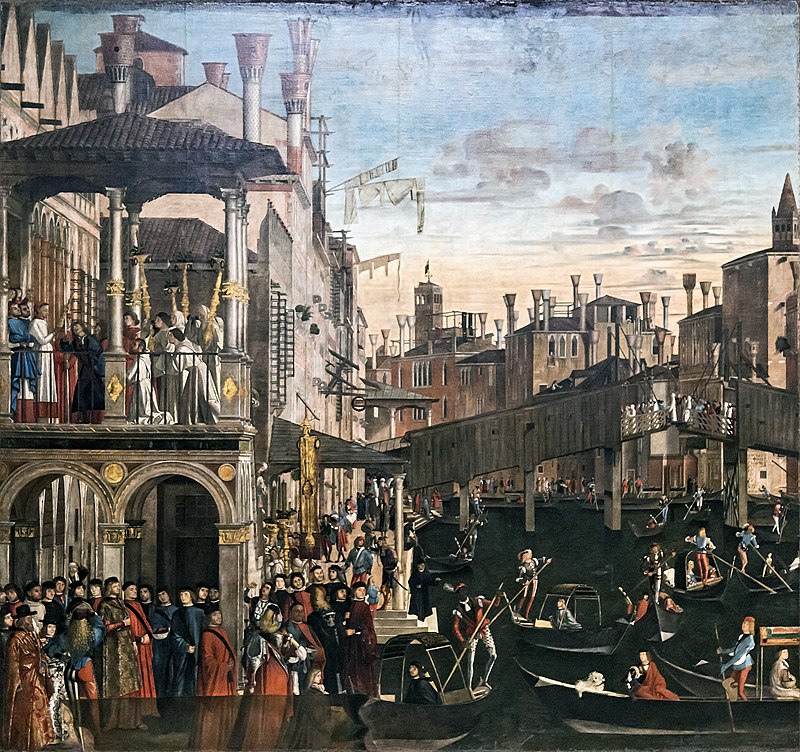Source: “The Miracle of the Relic of the True Cross on the Rialto Bridge”: Enslaved Africans in Renaissance Venice


This painting by Vittore Carpaccio, a Venetian artist who frequently depicted both religious scenes and compositions from daily life in Venice, is an example of what art historians refer to as “history narrative paintings”: paintings of scenes where the success of the presentation was based on how close the details of dress, architecture, and social interaction were rendered to life-like accuracy. Accordingly, Carpaccio presents a multicultural environment, with merchant travelers from Armenia, Turkey, and Arabia mingling with the Venetians under the famed bridge at the heart of the city. Among these figures are two Black Africans (the more central of the two captured in the detail) working as gondoliers. While it is always difficult to ascertain if a depicted individual, particularly an individual with darker skin, is a slave—unless they are painted or sculpted with chain, perhaps—numerous scholars have identified these figures either as enslaved individuals, probably in domestic service, or as former slaves who continued their work as gondoliers after their manumission. It is important to note that while many Black Africans in Italy at the time were slaves transported to Europe under the burgeoning African slave trade, slavery was not racialized in the sense that Black skin automatically made one a slave, as in the American South. There were many free Black residents of Venice. Art historian Kate Lowe, who has studied this painting in detail, makes two points of note. First, gondoliers in Venice operated under a guild-like system; many guilds at the time permitted slaves and ex-slaves to join their ranks. Second, there may have been a stereotype in 15th century Venice that Africans, particularly those born in Africa, had superior skill in water-related occupations by virtue of coastal upbringings in the West African regions that were the source of many slaves.
Contributed by Frances Hisgen. This contribution CC BY-NC-ND 4.0.
Discussion Questions
- Are the two Black Africans in the painting depicted differently from the other people in the scene? What might their depiction say about the status of Black Africans in 15th century Venice?
- Many scholars have analyzed this painting and others as part of a quest to “unearth” images of Black people or other people of color in visual art from the Middle Ages and the Renaissance. What are some of the benefits, and some of the pitfalls, in historical scholarship geared towards demonstrating that this historical period was not entirely white?
- What comments about the racialization of slavery in this period might you make based off of this painting?
Related Primary Sources
- Criminal Trials of Slaves in Venice
- Initial Q from the Vidal Mayor: Two Soldiers Leading Two Slaves before a King
- Marco Polo’s Will
- A Slave Sale Contract from Venice
Related Secondary Sources
- Bindman, David, Henry Louis Gates, Karen C. C. Dalton, W. E.B. Du Bois Institute for African and African American Research, and Menil Collection. The Image of the Black in Western Art. Cambridge, Massachusetts; Houston, Texas: Belknap Press of Harvard University Press, 2010.
- Spicer, Joaneath A., Natalie Zemon Davis, K. J. P. Lowe, and Ben Vinson. Revealing the African Presence in Renaissance Europe. Baltimore: Walters Art Museum, 2012.
- Kate Lowe. “Visible Lives: Black Gondoliers and Other Black Africans in Renaissance Venice.” Renaissance Quarterly 66, no. 2 (2013): 412–452.
